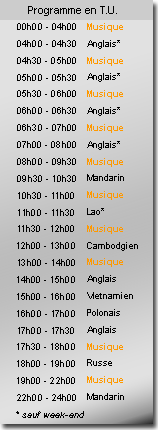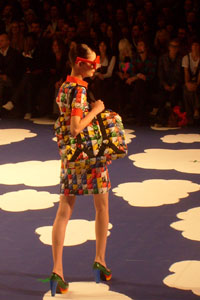Is Paris fashion feeling the pinch?
by Carly Jane Lock
Article published on the 2008-10-04 Latest update 2008-10-08 13:02 TU
As Paris hosts the fourth and final leg of International Fashion Week, Carly-Jane Lock looks at the effects of the economic downturn on Paris' fashion industry. How are designers dealing with the gloom on the financial markets? Is the French capital still the most popular fashion week venue?
Culture: Paris fashion week and the economic downturn
While the world faces its worst economic crisis since the depression of the 1930s, designers at Paris fashion week looked beyond the gloom on the financial markets as they continued to push fashion forward.
Karl Lagerfeld, described his Chanel collection as "post-Depression romanticism" while Belgian designer Dries Van Noten defined his latest fashion moment as “warm modernism”. Nevertheless, the dramatic swings of Wall street were reflected on the Spring/Summer runways, which saw the rise-and-fall of the hemline: at Balmain, Nina Ricci, Kenzo, Paul & Joe, and Emanuel Ungaro micro hemlines morphed seamlessly into billowy floor-grazing gowns.
Other trends mirroring the economic uncertainty included an urge to merge skirts and trousers, resulting in an abundance of harem pants on the catwalks. Harem pants aside… this season saw designers take more cautiously calculated risks as the world’s fashion houses are becoming more consumer-centric. Designers such as Alexander McQueen, John Galliano and Christian Lacroix moved away from the melodrama of their previous lines as they presented what the fashion professionals dubbed some of their most subdued and commercially viable ready-to-wear collections to date.
The editor of Focus magazine, Anne de Champignol, explained that while consumers are looking to high-street chains for more cost-effective ways of feeding their passion for fashion, they aren’t turning their backs on designer labels. The abundance of accessories on the catwalk indicate that designers are responding to a renewed interest in designer bags and shoes which, for the average woman, are less likely to break the bank than ready-to-wear clothing.
While toasting designer apparel when the world’s financial markets are on the verge of implosion may seem like a contradiction in terms, many designers argue that, whatever the state of the economy, there will always be a strong demand for prêt-à-porter. “I believe fashion can get us through the depression. It’s the ultimate mood-booster and people are willing to pay for that. Besides, buying beautiful clothes is much less expensive than buying a house or a car,” said Turkish designer Ece Ege at Paris-based fashion house Dice Kayek.
Dice Kayek’s optimism was shared by Lie Sang Bong, Valentino and Lanvin whose colourful collections offered a brighter vision of the future. Green (particularly shades of olive, lime and celadon) replaced last season’s grey as "the new black" for a host of designers including Issey Miyake, Alexander McQueen, Chloé and John Galliano.
Other designers chased away the black clouds hanging over the financial markets by giving us escapism. References ranging from the tribal arts of Africa and Indian textile crafts to the Amazon rainforest were seen in collections by Tsumori Chisato, Léonard and Andrew GN. Dior and Lanvin’s spring/summer lines reworked colourful animal prints while curious insect prints were spotted at the Alexander McQueen show.
French designer Jean-Charles de Castelbajac opted for playground-inspired fashion, which mixed primary colours and comic strip style prints featuring little fluffy clouds and Lego bricks. Never one to play it safe, the French designer "rocked the vote" as he sent a model down the runway in a sequined Barack Obama dress in a candid show of support to the US democratic presidential candiate. Transparency - something the world’s financial institutions would do well to adopt - was a key look at Paris fashion week: mesh inserts, see-through shoes and flesh-revealing creations in tulle, chiffon, mousseline, lace in soft pastel, nude and metallic shades flooded the ready-to-wear catwalks at shows by John Galliano, Valentino, Yves Saint Laurent, Anne Valérie Hash and Sharon Wauchob.
Paris-based fashion houses Lanvin and Dice Kayak laughed in the face of the grim reality of the global economy as they unveiled their collections of unashamed party wear. Their lines carried on last season’s trend for excessive volume: tulip skirts in luxurious fabrics and couture-inspired dresses were whipped up into cloud-like proportions, and looked quite literally as though they were ready for take off as they came down the runway.
There was less emphasis on belt-tightening than in previous seasons. A softer version of last season’s built-up silhouettes centred around generously cut asymmetrical shoulder designs and an exaggerated hipline as seen in the moulded-hip and hourglass shapes and cocoon dresses at Lanvin and Alexander McQueen.
Culture
Cracking skulls!
2010-02-15 12:35 TU
France's gothic avant-garde
2010-02-13 15:16 TU
Winter sounds warm up French jazz fans
A tribute to trumpeter Don Cherry at a Free Jazz showcase festival outside of Paris.
2010-01-31 11:55 TU
Trance on a trapeze
2010-01-30 12:41 TU
Retro Mobile - classic car exhibition
260,500 euros for rusty old car found at bottom of lake
A rusty old Bugatti, which spent years at the bottom of a Swiss lake, sold for 260,500 euros at the Retro Mobile classic car exhibition on Saturday. Other more lovingly-restored pristine examples are exciting enthusiasts from across the world in a special anniversary event at Porte de Versailles in Paris.
2010-01-23 20:21 TU
France's changing face looks east
2010-01-22 16:17 TU
Putting art on film
2010-01-20 13:09 TU
What sex is a coffee bean, where does the aubergine come from?
2010-01-08 16:08 TU
Cocteau Twin flying solo
2010-01-06 16:43 TU
A taste of Nordic filmmaking in Paris
Ciné Nordica 2009 at Paris’s Panthéon cinema showcases filmmaking from Scandinavia. So what makes Nordic film different from the rest?
2009-12-22 17:15 TU


















